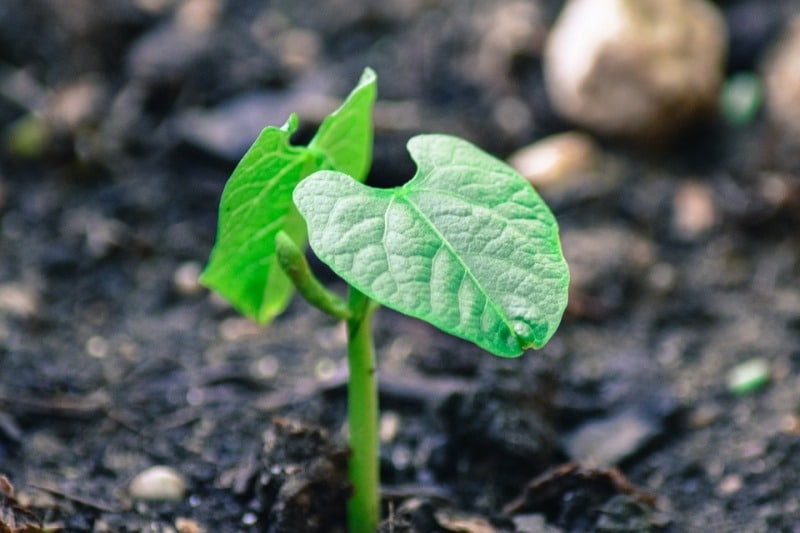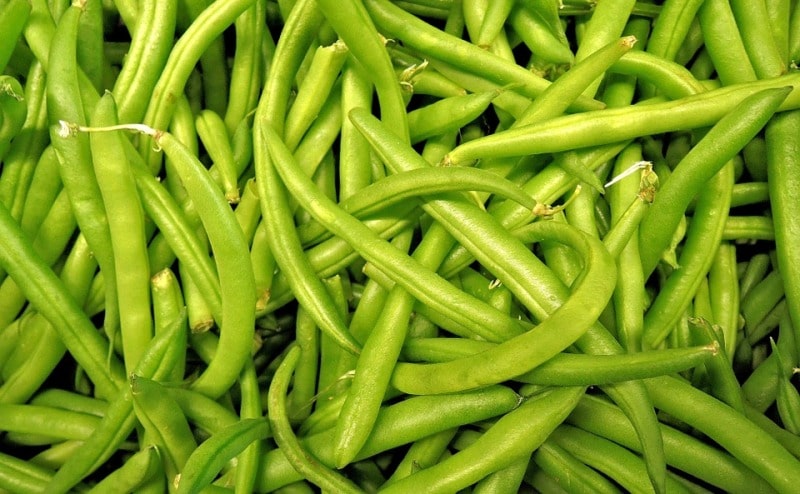Green Beans Backyard Gardening Techniques, Tips
Today, we learn the topic of green beans backyard gardening techniques and ideas. Green beans are moderate and can also be grown in a simple way at the times of summer and autumn. They will provide tasty food at the same time providing us with good health. These beans are very sensitive to the temperatures which are cold or any other conditions which are not suitable and you will need to make sure that you are watering them on a daily basis. There is a chance for you to grow pole varieties and bush varieties under similar climatic conditions. Bush beans are the ones which take lesser time to reach the stage of maturity than the pole beans. But the pole beans will be impressive in terms of appearance in most cases. In this article, we will discuss green beans backyard gardening how or how to grow green beans in your backyard.

Read: Growing Hydroponic Herbs.
Choosing the beans and preparation of soil:
- The basic varieties of green beans are pole beans and bush beans. The bushes present in the bush beans will spread across the ground and they will grow for about 2 feet tall.
- The bush beans which are white will only produce one harvest at the time of the growing season. They are very much easy to grow and also not require tending so much.
- Bush beans are the ones which will spread in a horizontal way whereas the pole beans will have to climb in a vertical direction. Bush beans will not need any type of support present in the backyard whereas the pole beans will need a trellis for the purpose of climbing as support.
- The varieties of bush beans which are recommended for most of the regions are Bountiful and Bush Blue Lake.
Plantation of Pole Beans:
- Pole beans are the ones which will reach the stage of maturity very quickly than the bush beans. This means that you can harvest the pole beans much earlier. These pole beans will also give rise to beans continuously at the time of the growing season, so you will get a huge quantity of beans from each and every plant.
- The varieties of pole beans which are recommended for most of the regions are Fortex.
- You will need to go for the installation of a trellis for your pole beans so that they can climb. These trellises are like wooden lattice, garden trellis, cattle panel etc.
- Green beans will require lots of sunlight in order to grow in a proper manner. So make sure that you are trying to select an area in your backyard which will receive full sun for your site of the plantation.
- As the green beans will not do that well in the soil which is heavily moist, you will need to avoid the locations which are shaded as the shade will tend to help in retaining the moisture in the soil for extended periods.
- Green beans will survive in the soil which is loamy. So, if your backyard area has the clay soil which is heavy or the soil which is sandy, you will need to make amendments to it by the addition of organic material prior to the plantation of your green beans. Loamy soil is crumbly and also dark. The soil has to be tested by squeezing it by making use of your hands. Clay soil stays in the form of a ball whereas the soil which is sandy will completely fall apart. Loamy soil will retain its shape in the initial stage and then breaks apart if you touch it.
- If you are working with heavy clay soil, you will need to spread about 2 inches of compost or manure all over the soil and dig into 1 foot at the top of the soil by making use of a garden fork or shovel. You can also take into consideration adding sand or sawdust into the soil if it is heavy particularly.
- If you are dealing with the soil which is sandy, you will need to spread the equal amount of compost or manure into the soil in a similar way, but always remember to avoid the sawdust.
- Irrespective of the type of soil you have in your backyard, you will need to always make sure that the area has no weeds, stones, debris or any other trash.
- Green beans will not need a plenty amount of nutrients, but a little application of fertilizer will help your green bean plants to grow in a better way. You can make use of a shovel add the fertilizer into the top 4 inches of the soil.
- The fertilizer which is in the ratio of 10-20-10 will be perfect as it has the high content of phosphorus than the potassium and nitrogen. Hence it would be perfect for the good growth of the plants. If you tend to choose a fertilizer which has a high content of nitrogen, then your bean plant will give rise to lots of leaves but it will have very fewer beans.
Read: How to Grow Vegetables in Hydroponics.

Plantation in green beans backyard gardening:
- The soil temperature which is ideal for the green beans at the stage of the plantation is 13°C. The temperature should increase to 26°C as soon as the plants will reach the stage of an emergency. The temperature of soil fo the seeds of green beans is 10°C.
- If the temperature of soil decreases than this, even during the nights, there is a chance that the seeds do not undergo germination in a good manner which will, in turn, result in the slow growth.
- A trellis will not be required if you are going with the plantation of bush beans. But if you are growing pole beans, the use of trellis is mandatory as it will affect the growth of the plants if it is not used.
- The best and simple support you can provide to your pole bean plants is a cattle panel. This is a tiny section of a wire fence which will measure about 18 feet x 7 feet. You can set up the fence in a simple manner behind your area of growing prior to the plantation of seeds.
- You can also make use of a pyramid trellis which is being used traditionally for several years or you can also go with a stake which is made up of metal or plastic.
- You will need to place any of the above just behind the location of plantation and always ensure that the 4 inches at the bottom are lying underground.
- Each and every seed has to be about 5 inches distant from each other and should be lightly covered with the soil which is loose. If you see that your soil is sandy, you can start planting the seeds a bit deeper. If you are going with the plantation of several rows of beans, leave at least 2 feet of space in between each and every row.
- The seeds should not be soaked prior to plantation or immediately after the plantation. When the seeds are exposed to an excess amount of moisture, the seeds of green bean will break or crack.
- Each and every seed has to be sown at a distance of a minimum of 2 inches. Make use of your fingers for pressing the seeds into the soil individually. If you are going with the plantation of pole beans, they should be given even more space.
- The pole bean seeds have to be planted at a distance of 5 inches from each other.
- It is always better not to sow the seeds in the indoor locations as the green beans will not survive when transplanted in a good manner. The seedlings will have very less time to survive after transplantation.
- The wood chip mulch or even straw will work in a good manner with the green beans. Mulch will help in the prevention of soil from becoming too much cool or warm. This will also help to retain the moisture in the soil. The mulch has to be applied for at least 3 times over the plants after you see that the soil has begun to warm up.
- Other types of mulches which are good will be like untreated lawn clippings and weathered straw. Always make sure that you are using grass clippings so that they will not consist of pesticides as mulch.
- Mulch will also help in the prevention of the spread of weeds.
Read: Types of Garden Mulch.
Care and maintenance of green beans:
- Watering of green bean plants has to be done in the morning. They should not be watered during the rainy season or cloudy weathers. The watering should be done on the days which are sunny so that there will be no chance to the moisture to soak the foliage. The plants have to be given 1.5 inches of water on a weekly basis.
- It is always suggested not to water the green bean plants in the middle of the day as there is a chance of evaporation.
- Weeds will affect the green beans in such a way that it will be tough for them to grow from the surface of the soil and if they once start growing, they will strangle them. The weeds have to be removed immediately after you see them so that there would be a good growth of green beans.
- When you are removing the weeds, make sure that you are not digging for too much depth. The root system of the green beans is shallow and hence if you dig deep into the surface of the soil, it may cause damage to them.
- Make sure that you are not starting to weed when the foliage appears wet as it may increase the risk of the diseases to it.
- Pests and diseases: There are several pests and diseases to which the green beans are prone to. For this, you will have to apply organic insecticides and fungicides to the plants as required in order to avoid these problems and regulate them. Sulfur and neem oil are generally the fungicides which are adequate.
- Green beans are mainly attractive to spider mites, cutworms, aphids, and Japanese beetles and are mainly weak against the mosaic viruses and white mould.
- Make sure that you are getting rid of the cutworms by making use of the insecticide names Bacillus thuringiensis. The aphids and spider mites can be avoided by pouring water onto your leaves and hosing them off the leaves.
Read: How to Grow Artichokes in Pots.
Harvesting Green beans:

- In order to harvest the green beans, the pods have to be in a firm manner and they should be in such a way that you are able to snap them off by making use of your fingers. Green beans will generally have a size of a tiny pencil when they are ready for harvesting. Harvesting will generally take place in 2 months from plantation and 2 weeks after the stage of full blossom.
- If you give so much time for the beans to reach the stage of maturity, the pods will become more and more stingy and there would be the development of tough external skin.
- Always remember that the seeds present inside the green beans should never be allowed to develop completely. If so, the seeds present internally will become hard.
Storage of green beans:
- The harvested beans have to be kept in a container which has air-tight lid and store for about a week in the refrigerator.
- You can freeze the green beans for approximately 6 months.
That’s all folks about green beans backyard gardening techniques.
Read: Tomato Cultivation Guide.